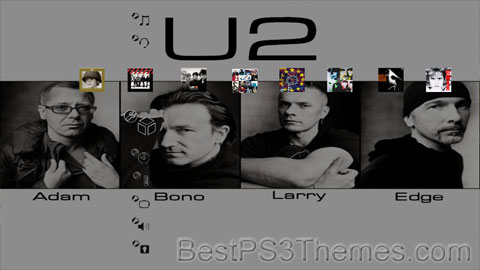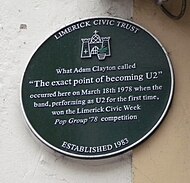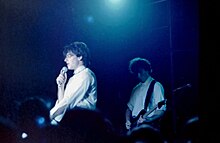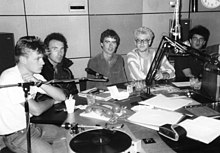U2 theme by MrToffee
Download: U2.p3t

(8 backgrounds)
U2 | |
|---|---|
 U2 performing in Brussels, Belgium, August 2017. from left to right: Larry Mullen Jr.; The Edge; Bono; Adam Clayton | |
| Background information | |
| Also known as |
|
| Origin | Dublin, Ireland |
| Genres | |
| Discography | |
| Years active | 1976–present |
| Labels | |
| Members | |
| Past members |
|
| Website | u2 |
U2 are an Irish rock band formed in Dublin in 1976. The group consists of Bono (lead vocals and rhythm guitar), the Edge (lead guitar, keyboards, and backing vocals), Adam Clayton (bass guitar), and Larry Mullen Jr. (drums and percussion). Initially rooted in post-punk, U2's musical style has evolved throughout their career, yet has maintained an anthemic quality built on Bono's expressive vocals and the Edge's chiming, effects-based guitar sounds. Bono's lyrics, often embellished with spiritual imagery, focus on personal and sociopolitical themes. Popular for their live performances, the group have staged several elaborate tours over their career.
The band was formed when the members were teenaged pupils of Mount Temple Comprehensive School and had limited musical proficiency. Within four years, they signed with Island Records and released their debut album, Boy (1980). Works such as their first UK number-one album, War (1983), and singles "Sunday Bloody Sunday" and "Pride (In the Name of Love)" helped establish U2's reputation as a politically and socially conscious group. Their fourth album, The Unforgettable Fire (1984), was their first collaboration with producers Brian Eno and Daniel Lanois, whose influence resulted in a more abstract, ambient sound for the band. By the mid-1980s, U2 had become renowned globally for their live act, highlighted by their performance at Live Aid in 1985. Their fifth album, The Joshua Tree (1987), made them international stars and was their greatest critical and commercial success. One of the world's best-selling albums with 25 million copies sold, it produced the group's only number-one singles in the US to date: "With or Without You" and "I Still Haven't Found What I'm Looking For".
Facing creative stagnation and a backlash to their documentary and double album Rattle and Hum (1988), U2 reinvented themselves in the 1990s. Beginning with their acclaimed seventh album, Achtung Baby (1991), and the multimedia spectacle of the Zoo TV Tour, the band pursued a new musical direction influenced by alternative rock, electronic dance music, and industrial music, and they embraced a more ironic, flippant image. This experimentation continued on Zooropa (1993) and concluded with Pop (1997) and the PopMart Tour, which were mixed successes. U2 regained critical and commercial favour with the records All That You Can't Leave Behind (2000) and How to Dismantle an Atomic Bomb (2004), returning to a more conventional, mainstream sound. Although their twelfth album, No Line on the Horizon (2009), did not meet commercial expectations, the supporting U2 360° Tour of 2009–2011 set records for the highest-attended and highest-grossing concert tour, both of which stood until 2019. In the 2010s, U2 released two companion albums: Songs of Innocence (2014), which received criticism for its pervasive, no-cost release through the iTunes Store; and Songs of Experience (2017). In 2023, U2 released Songs of Surrender, an album of re-recorded songs, and began the U2:UV Achtung Baby concert residency at the Sphere in the Las Vegas Valley.
U2 have released 15 studio albums and are one of the world's best-selling music artists, having sold an estimated 150–170 million records worldwide.[1] They have won 22 Grammy Awards, more than any other band, and in 2005, they were inducted into the Rock and Roll Hall of Fame in their first year of eligibility. Rolling Stone ranked U2 at number 22 on its list of the "100 Greatest Artists of All Time".[2] Throughout their career, as a band and as individuals, they have campaigned for human rights and social justice causes, working with organisations and coalitions that include Amnesty International, Jubilee 2000, DATA/the ONE Campaign, Product Red, War Child, and Music Rising.
History[edit]
Formation and early years (1976–1980)[edit]

In 1976, Larry Mullen Jr., then a 14-year-old pupil of Mount Temple Comprehensive School in Dublin, Ireland, posted a note on the school's notice board in search of musicians for a new band. At least five people responded and attended the first practice, which was held on 25 September in Mullen's kitchen. Mullen played drums and was joined by: Paul Hewson ("Bono") on lead vocals; David Evans ("the Edge") and his older brother Dik Evans on guitar; Adam Clayton, a friend of the Evans brothers, on bass guitar; and Ivan McCormick. Mullen later described it as "'The Larry Mullen Band' for about ten minutes, then Bono walked in and blew any chance I had of being in charge." Peter Martin, a friend of Mullen and McCormick, loaned his guitar and amplifier for the first practice,[3] but he could not play and was quickly phased out;[4] sources differ on whether he was in attendance at the first meeting or not.[5] McCormick was dropped from the group after a few weeks.[6] The remaining five members settled on the name "Feedback" for the group because it was one of the few technical terms they knew. Early rehearsals took place in their music teacher's classroom at Mount Temple.[3] Most of their initial material consisted of cover songs, which they admitted was not their forte.[7] Emerging punk rock acts such as the Stranglers,[8] the Jam, the Clash, Buzzcocks, and Sex Pistols were strong influences on the group. The popularity of punk convinced them that musical proficiency was not a prerequisite to success.[9]
We couldn't believe it. I was completely shocked. We weren't of an age to go out partying as such but I don't think anyone slept that night ... Really, it was just a great affirmation to win that competition, even though I've no idea how good we were or what the competition was really like. But to win at that point was incredibly important for morale and everyone's belief in the whole project.
—The Edge, on the band's winning a 1978 talent contest in Limerick[10]
In April 1977, Feedback played their first gig for a paying audience at St. Fintan's High School. Shortly thereafter, the band changed their name to "The Hype".[11] Dik Evans, who was older and by that time attending college, was becoming the odd man out. The rest of the band was leaning towards the idea of a four-piece ensemble.[10] In March 1978, the group changed their name to "U2".[12] Steve Averill, a punk rock musician with the Radiators from Space and a family friend of Clayton's, had suggested six potential names from which the band chose U2 for its ambiguity and open-ended interpretations, and because it was the name that they disliked the least.[13] Dik Evans was officially phased out of the band with a farewell concert at the Presbyterian Hall in Sutton on 4 March. During the show, which featured the group playing cover songs as the Hype, Dik ceremonially walked offstage. The remaining four band members returned later in the concert to play original material as U2.[10][14] Dik joined another band, the Virgin Prunes, which comprised mutual friends of U2's; the Prunes were their default opening act early on, and the two groups often shared members for live performances to cover for occasional absences.[15] On 18 March, the four-piece U2 won the "Pop Group '78" talent contest sponsored by the Evening Press and Guinness's Harp Lager as part of Limerick Civic Week.[16] The win was an important milestone and affirmation for the fledgling act.[10] The contest prize consisted of £500 and a recording session for a demo that would be heard by record label CBS Ireland.[17] U2's demo tape was recorded at Keystone Studios in Dublin in April 1978,[17] but the results were largely unsuccessful due to their inexperience.[18]

Irish magazine Hot Press was influential in shaping U2's future; in addition to being one of their earliest allies, the publication's journalist Bill Graham introduced the band to Paul McGuinness, who agreed to be their manager in mid-1978.[17][19] With the connections he was making within the music industry, McGuinness booked demo sessions for the group and sought to garner them a record deal. The band continued to build their fanbase with performances across Ireland,[20] the most famous of which were a series of weekend afternoon shows at Dublin's Dandelion Market in the summer of 1979.[21][22] In August, U2 recorded demos at Windmill Lane Studios with CBS talent scout Chas de Whalley as producer, marking the first of the band's many recordings at the studio during their career.[23] The following month, three songs from the session were released by CBS as the Ireland-only EP Three. It was the group's first chart success, selling all 1,000 copies of its limited edition 12-inch vinyl almost immediately.[21] In December 1979, the band performed in London for their first shows outside Ireland, although they were unable to gain much attention from audiences or critics.[24] On 26 February 1980, their second single, "Another Day", was released on the CBS label, but again only for the Irish market. The same day, U2 played a show at the 2,000-seat National Stadium in Dublin as part of an Irish tour.[25][26] Despite their gamble of booking a concert in such a large venue, the move paid off.[25] Bill Stewart, an A&R representative for Island Records, was in attendance and offered to sign them to the label.[27] The following month, the band signed a four-year, four-album contract with Island, which included a £50,000 advance and £50,000 in tour support.[28]
Boy and October (1980–1982)[edit]

In May 1980, U2 released "11 O'Clock Tick Tock", their first international single and their debut on Island, but it failed to chart.[28] Martin Hannett, who produced the single, was slated to produce the band's debut album, Boy, but ultimately was replaced with Steve Lillywhite.[29] From July to September 1980, U2 recorded the album at Windmill Lane Studios,[30][31] drawing from their nearly 40-song repertoire at the time.[32] Lillywhite suggested recording Mullen's drums in a stairwell, and recording smashed bottles and forks played against a spinning bicycle wheel.[29] The band found Lillywhite to be very encouraging and creative; Bono called him "such a breath of fresh air", while the Edge said he "had a great way of pulling the best out of everybody".[29] The album's lead single, "A Day Without Me", was released in August. Although it did not chart,[30] the song was the impetus for the Edge's purchase of a delay effect unit, the Electro-Harmonix Memory Man, which came to define his guitar playing style and had a significant impact on the group's creative output.[28]
Released in October 1980,[33] Boy received generally positive reviews.[34] Paul Morley of NME called it "touching, precocious, full of archaic and modernist conviction",[35] while Declan Lynch of Hot Press said he found it "almost impossible to react negatively to U2's music".[36] Bono's lyrics reflected on adolescence, innocence, and the passage into adulthood,[37] themes represented on the album cover through the photo of a young boy's face.[29] Boy peaked at number 52 in the United Kingdom and number 63 in the United States.[33][38] The album included the band's first songs to receive airplay on US radio, including the single "I Will Follow",[39] which reached number 20 on the Top Tracks rock chart.[40] Boy's release was followed by the Boy Tour, U2's first tour of continental Europe and the US.[41] Despite being unpolished, these early live performances demonstrated the band's potential, as critics complimented their ambition and Bono's exuberance.[42]

The band faced several challenges in writing their second album, October. On an otherwise successful American leg of the Boy Tour, Bono's briefcase containing in-progress lyrics and musical ideas was lost backstage during a March 1981 performance at a nightclub in Portland, Oregon.[43][44] The band had limited time to write new music on tour and in July began a two-month recording session at Windmill Lane Studios largely unprepared,[45] forcing Bono to quickly improvise lyrics.[43] Lillywhite, reprising his role as producer, called the sessions "completely chaotic and mad".[46] October's lead single, "Fire", was released in July and was U2's first song to chart in the UK.[45][47] Despite garnering the band an appearance on UK television programme Top of the Pops, the single fell in the charts afterwards.[43] On 16 August 1981, the group opened for Thin Lizzy at the inaugural Slane Concert, but the Edge called it "one of the worst shows [U2] ever played in [their] lives".[45] Adding to this period of self-doubt, Bono's, the Edge's, and Mullen's involvement in a Charismatic Christian group in Dublin called the "Shalom Fellowship" led them to question the relationship between their religious faith and the lifestyle of a rock band.[43][48] Bono and the Edge considered quitting U2 due to their perceived spiritual conflicts before deciding to leave Shalom instead.[43][49]

October was released in October 1981 and contained overtly spiritual themes.[50] The album received mixed reviews and limited radio play,[51] and although it debuted at number 11 in the UK,[50] it sold poorly elsewhere.[52] The single "Gloria" was U2's first song to have its music video played on MTV, generating excitement for the band during the October Tour of 1981–1982 in markets where the television channel was available.[53] During the tour, U2 met Dutch photographer Anton Corbijn,[54] who became their principal photographer and has had a major influence on their vision and public image.[55] In March 1982, the band played 14 dates as the opening act for the J. Geils Band, increasing their exposure.[56] Still, U2 were disappointed by their lack of progress by the end of the October Tour. Having run out of money and feeling unsupported by their record label, the group committed to improving; Clayton recalled that "there was a firm resolve to come out of the box fighting with the next record".[52]
War and Under a Blood Red Sky (1982–1983)[edit]
After the October Tour, U2 decamped to a rented cottage in Howth, where they lived, wrote new songs, and rehearsed for their third album, War. Significant musical breakthroughs were achieved by the Edge in August 1982 during a two-week period of independent songwriting, while the other band members vacationed and Bono honeymooned with his wife, Ali.[57][58] From September to November, the group recorded War at Windmill Lane Studios. Lillywhite, who had a policy of not working with an artist more than twice, was convinced by the group to return as their producer for a third time.[59][60] The recording sessions featured contributions from violinist Steve Wickham and the female singers of Kid Creole and the Coconuts.[59] For the first time, Mullen agreed to play drums to a click track to keep time.[57] After completing the album, U2 undertook a short tour of Western Europe in December.[61]
War's lead single, "New Year's Day", was released in January 1983. It reached number 10 in the UK and became the group's first hit outside of Europe; in the US, it received extensive radio coverage and peaked at number 53.[62] Resolving their doubts of the October period,[63] U2 released War in February.[62] Critically, the album received favourable reviews, although a few UK reviewers were critical of it.[64] Nonetheless, it was the band's first commercial success, debuting at number one in the UK, while reaching number 12 in the US.[62] War's sincerity and "rugged" guitar were intentionally at odds with the trendier synthpop of the time.[65] Described as a record on which the band "turned pacifism itself into a crusade",[66] War was lyrically more political than their first two records,[67] focusing on the physical and emotional effects of warfare.[59] The album included the protest song "Sunday Bloody Sunday", in which Bono lyrically tried to contrast the events of the 1972 Bloody Sunday shooting with Easter Sunday.[57] Other songs from the record addressed topics such as nuclear proliferation ("Seconds") and the Polish Solidarity movement ("New Year's Day").[68] War was U2's first record to feature Corbijn's photography.[69] The album cover depicted the same young child who had appeared on the cover of their debut album, albeit with his previously innocent expression replaced by a fearful one.[62]

On the subsequent 1983 War Tour of Europe, the US and Japan,[62] the band began to play progressively larger venues, moving from clubs to halls to arenas.[70] Bono attempted to engage the growing audiences with theatrical, often dangerous antics, climbing scaffoldings and lighting rigs and jumping into the audience.[71] The sight of Bono waving a white flag during performances of "Sunday Bloody Sunday" became the tour's iconic image.[72] The band played several dates at large European and American music festivals,[73] including a performance at the US Festival on Memorial Day weekend for an audience of 125,000 people.

